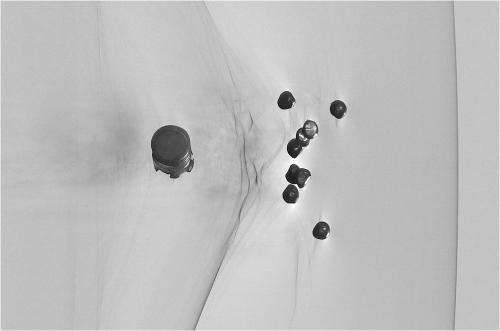Digital streak camera captures full-color photographs of high-speed objects

Researchers at MetroLaser, Inc., have developed a new design for a digital streak camera that captures full-color images of projectiles traveling up to 3350 m/s, which is 10 times the speed of sound. This system was designed to replace the outdated film-based streak cameras that are still in use at high-speed test tracks.
Film-based streak photography records the motion of an object as it passes in front of a camera lens, while the film moves behind a vertical slit aperture during the exposure. The result is a long, continuous composite image of the object.
However, the transition from film to digital has changed the photography industry, and the specialized film required for streak photography is no longer being manufactured. The U.S. Air Force asked Benjamin Buckner and Drew L'Esperance under a Small Business Innovation Research (SBIR) contract to design a system that could produce high-quality magazine-type images, as no existing digital technology exists that can capture images at the high speeds they require.
The new digital technology for this camera relies on a precisely controlled mirror to follow the object and freeze the image on the camera.
Buckner is the lead author of a paper describing the camera design in Optical Engineering. He explains that the galvo mirror tracks the object as it moves past the camera and directs the right portion of the object's image onto the right portion of the image sensor in order to form a complete, undistorted image.
Since the mirror is synchronized to a ballistic object, the biggest challenge is to accurately measure the object's speed, and calculate the swing of the mirror to match that speed precisely. "This has to be done in a few thousandths of a second," Buckner says.
The optical design also allows the wave of compressed air pushed along by the object (the schlieren effect) to be seen in the captured image. The camera is triggered by the motion of the object.
The digital streak camera was built to meet specifications established by operators of rocket sleds, which means that the camera is able to resolve an object 1.27 mm in size when the sled is traveling 3350 m/s, and must be able to operate outdoors in conditions of heat, cold, dust, and moisture.
The setup utilizes a commercial portrait quality digital camera and conventional photographic flash illumination. The software was designed to run efficiently on a compact, low-power computer, while maintaining a high level of mathematical accuracy.
"The real power of this approach is that you can take almost any kind of existing camera back and fit it into a rig like this to turn it into a high-speed streak camera," Buckner says.
Buckner and L'Esperance envision applications of digital streak imaging including ballistics, rocket sled imaging, and determining finishing order in high-speed races.
More information: The full paper is available in the SPIE Digital Library: "Digital synchroballistic schlieren camera for high-speed photography of bullets and rocket sleds."
Provided by SPIE



















